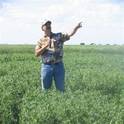
Soil and crop management practices may alter the quantity, quality, and placement of plant residues that influence soil C and N fractions. We examined the effects of two tillage practices [conventional till (CT) and no-till (NT)] and five crop rotations [continuous spring wheat (Triticum aestivum L.) (CW), spring wheat–fallow (W–F), spring wheat–lentil (Lens culinaris Medic.) (W–L), spring wheat–spring wheat–fallow (W–W–F), and spring wheat–pea (Pisum sativum L.)–fallow (W–P–F)] on transient land previously under 10 years of Conservation Reserve Program (CRP) planting on the amount of plant biomass (stems + leaves) returned to the soil from 1998 to 2003 and soil C and N fractions within the surface 20 cm in March 2004. A continued CRP planting was also included as another treatment for comparing soil C and N fractions. The C and N fractions included soil organic C (SOC), soil total N (STN), microbial biomass C and N (MBC and MBN), potential C and N mineralization (PCM and PNM), and NH4-N and NO3-N contents. A field experiment was conducted in a mixture of Scobey clay loam (fine-loamy, mixed, Aridic Argiborolls) and Kevin clay loam (fine, montmorillonitic, Aridic Argiborolls) in Havre, MT, USA. Plant biomass yield varied by crop rotation and year and mean annualized biomass was 45–50% higher in CW and W–F than in W–L. The SOC and PCM were not influenced by treatments. The MBC at 0–5 cm was 26% higher in W–W–F than in W–F. The STN and NO3-N at 5–20 cm and PNM at 0–5 cm were 17–1206% higher in CT with W–L than in other treatments. Similarly, MBN at 0–5 cm was higher in CT with W–L than in other treatments, except in CT with W–F and W–P–F. Reduction in the length of fallow period increased MBC and MBN but the presence of legumes, such as lentil and pea, in the crop rotation increased soil N fractions. Six years of tillage and crop rotation had minor influence on soil C and N storage between croplands and CRP planting but large differences in active soil C and N fractions.
- Crop rotation,
- Plant biomass,
- Carbon fractions,
- Nitrogen fractions,
- Tillage
Available at: http://works.bepress.com/andrew_lenssen/23/
